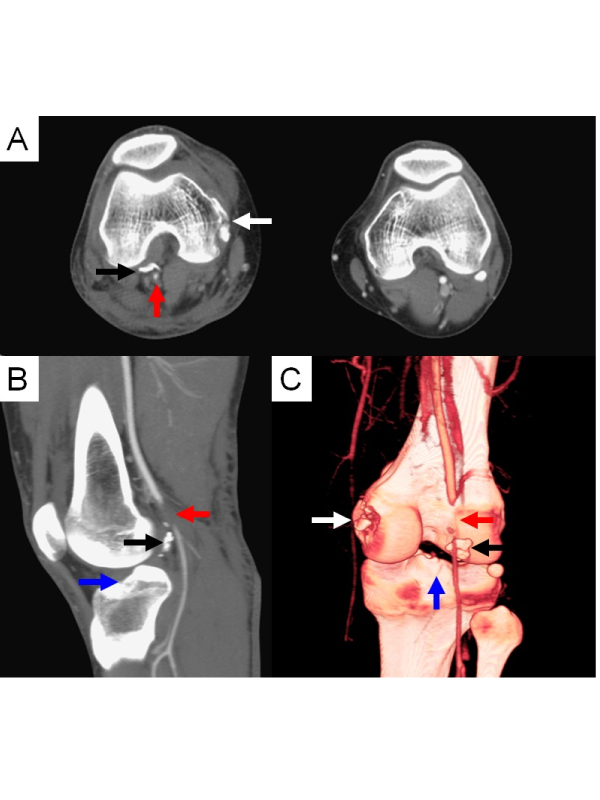2376-0249
Case Blog - International Journal of Clinical & Medical Images (2016) Volume 3, Issue 11

Author(s): Tzu-Chieh Lin, Chung-Lin Tsai, Jen-I Hwang and Sung-Yuan Hu
Case Presentation: A 31-year-old healthy Taiwanese man presented a cold extremity below right knee caused by contusion due to falling down in a traffic accident. Physical examination showed tenderness of right swollen knee with absent pulsation of right popliteal artery (PA) and weak pulsation of right dorsalis pedis artery. Contrast-enhanced multiple-detector computed tomography (MDCT) revealed the fractured bone fragments over medial epicondyle of right femur and intercondylar eminence of right tibia with adjacent hematoma and swelling. The fractured bone fragments of right tibial intercondylar eminence went posteriorly and injured the proximal portion of right PA. Focal occlusion of right PA was about 16 mm in length with collateral circulation filled the distal portion of right PA (Figure 1). The intimal rupture of right PA with acute thrombosis leading to occlusion caused by the fractured bone fragment was found. The emergent vascular repair with resection of the occlusive PA and reconstruction using the great saphenous vein were performed.
Discussion: Peripheral vascular injuries account for 4-6% of all major traumas. Popliteal vessel injuries, potentially with limb loss and a relativelyhigh morbidity, remain uncommon with an incidence of 0.2% in all traumas. The mechanisms of blunt PA injuries are secondary to posterior knee dislocation with traction, vascular avulsion, or bony fragments of complex tibial plateau or supracondylar femur fractures [1-4].
The PA injuries associated with blunt trauma have transection, occlusion, laceration, perforation, arteriovenous fistula, or intimal injury [2-4]. Vascular injury can have devastating consequences in patients, as irreversible ischemia can occur in as short as 6 to 8 hours [2,5]. Hard signs of PA injuries, including a pulsatile expanding hematoma, absence of pulse, presence of bruit or thrill, and ischemia of distal limbs, require emergency surgical intervention [1,5]. Early diagnostic images, including MDCT and digital substrate angiography which can confirm the location and severity of vascular injury, with vascular repair are recommended for limb-saving. An endovascular stent offers an alternative modality to traditional surgical repair [1-3,5].
 Awards Nomination
Awards Nomination

